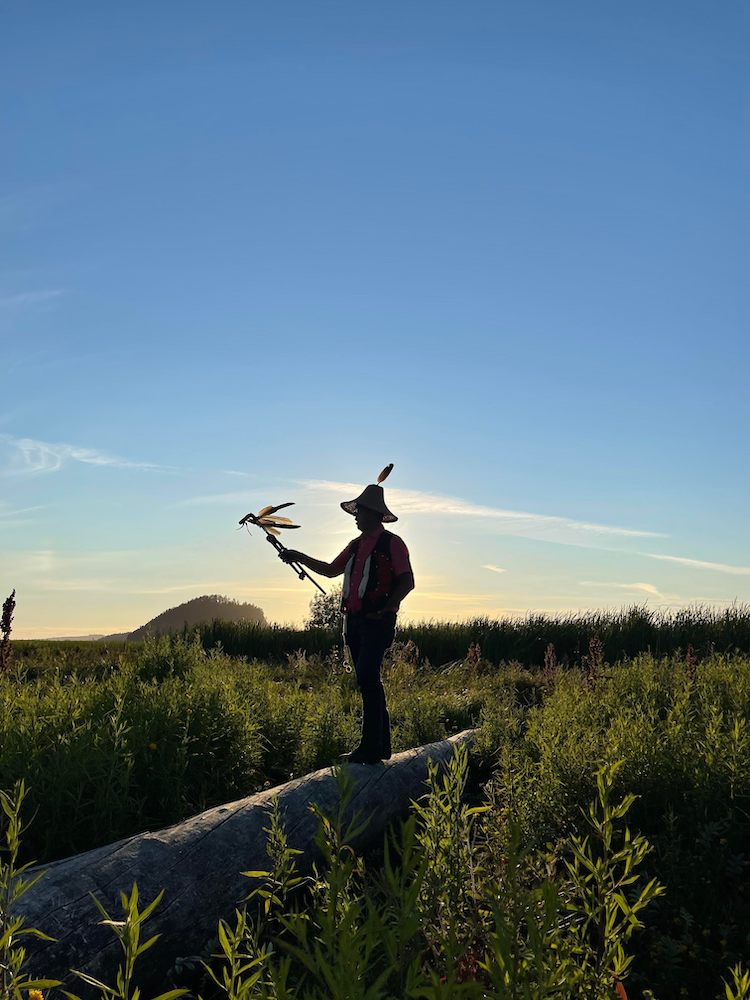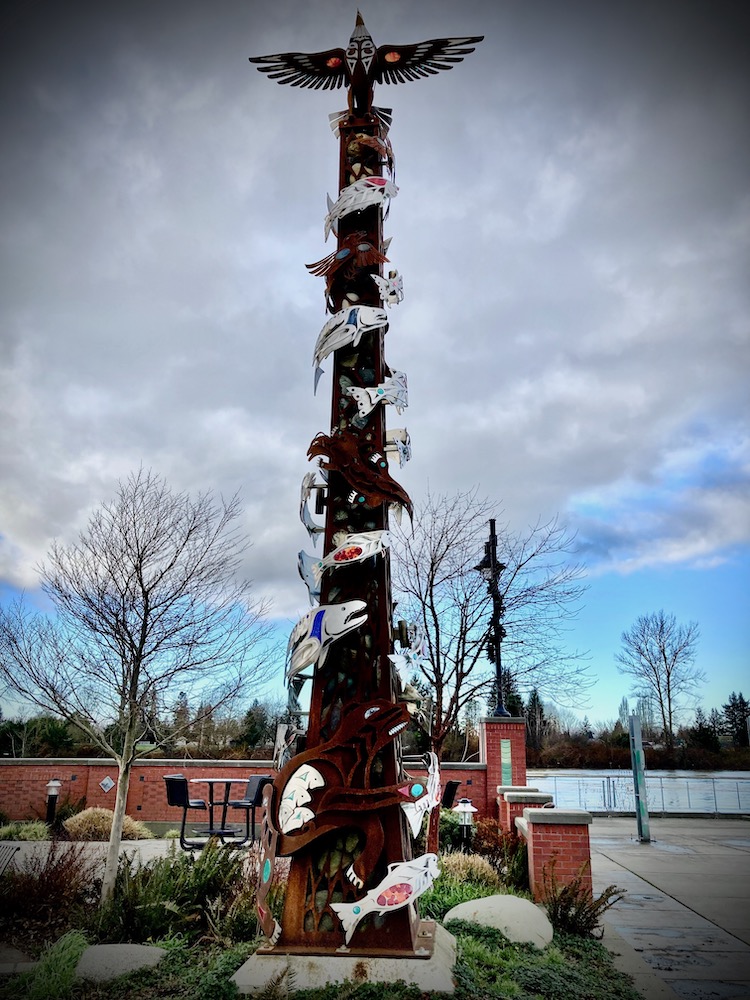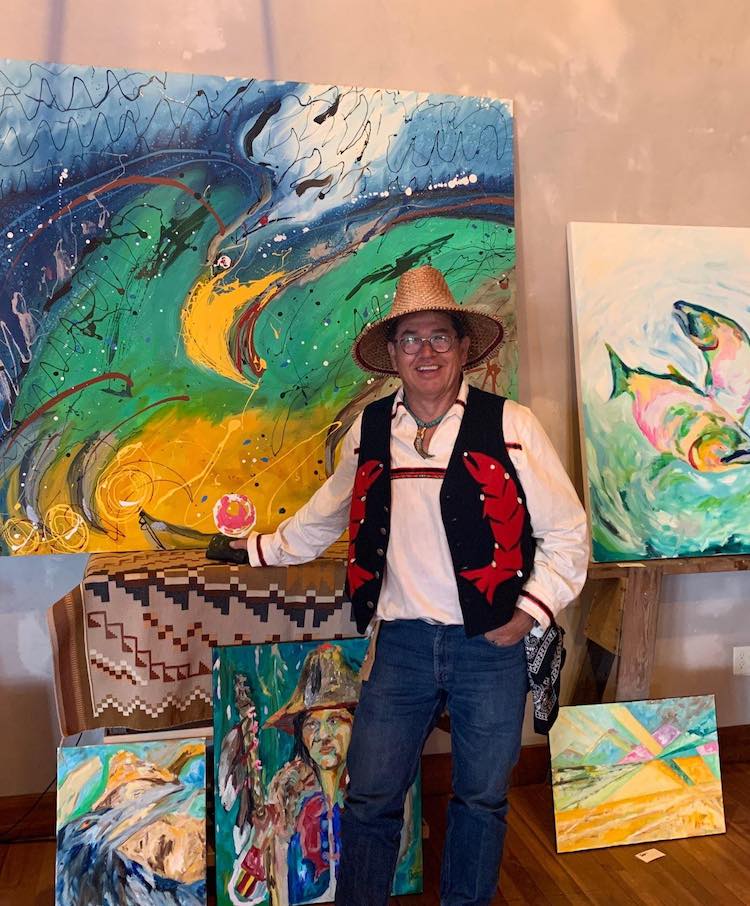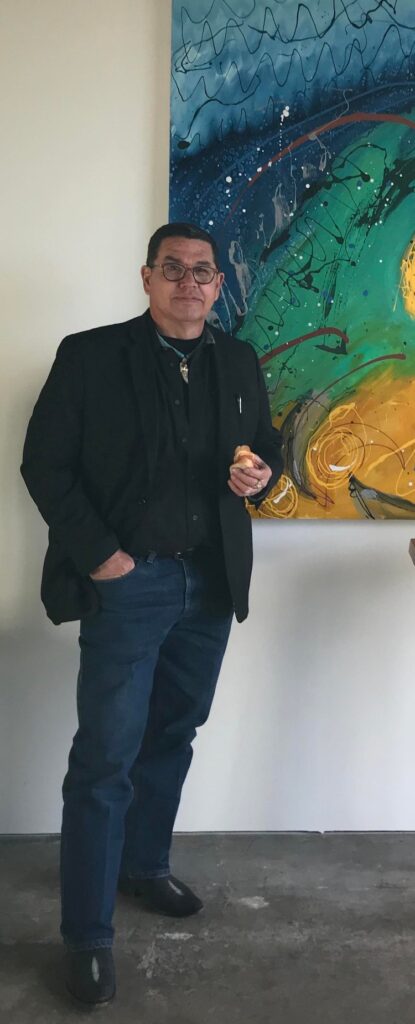Tales From the Magic Skagit: A “Simple Conversation” with Jay Bowen

“People ask me all the time, ‘What can I do…I feel so helpless.’ What we are doing right now is having this conversation. It all starts from a simple conversation.” – Jay Bowen
I first encountered Jay Bowen, or at least his voice, during the summer of 2020. I had decided to write a story about the “Valley of Our Spirits,” the 20-foot metal sculpture that rises compellingly over the plaza of Mount Vernon’s Riverwalk at the west end of Gates Street, and I had learned that its designer was a local artist and member of the Upper Skagit Tribe.
As it turned out, it was a story that stretched back 170 years to the time of Jay Bowen’s great, great grandfather — and when I began my phone interview with Jay, this story was first thing he told me. I repeat it here because it tells you a lot about the different worlds we humans inhabit, and it’s one that is central to Jay’s life as well as his art.
One evening, back in the mid-1800s, two explorers who were venturing up the Skagit River stepped out of the night and into a ceremonial circle of my great, great grandfather’s community. It was the first encounter between what my family subsequently referred to as the ‘New People’ and the people of the Upper Skagit who had been part of this landscape for thousands of years.
The story told by my family is that my great, great grandfather signaled for the men to sit down, and they were given a place of honor in the ceremonial circle. At a pause in the ceremony, my great, great grandfather put his staff in the ground and asked both men to come over and pull it up.
Now, these were two young, strong men who had just hiked 75 miles into the wilderness. They tried repeatedly to lift the staff out of the ground but were unable. My great, great grandfather went over and gently pulled the staff from the ground. He then put it back in the ground and flung it to one side so that it was swaying back and forth. He motioned for the men to come over and stop the staff from moving. Both came over to try, and both were thrown to the ground. My great, great grandfather reached out and stopped the staff’s motion, and again pulled it out of the ground. That was the first moment of the meeting of cultures.

How you respond to Jay’s story is a good indication of whether you grew up among the First Peoples of the Skagit Valley or among the “New People” who arrived with the last great immigrant wave, and who we celebrate at annual Pioneer Day festivities. I sensed a profound truth at the heart of this seemingly apocryphal tale, but I knew that the only way I’d find my way to it was to spend more time with Jay. Thanks to the Great Pandemic of 2020, however, it would take another year before I had that opportunity.
Fast forward to August 2021, in the midst of a Skagit Valley heat wave, and my wife and I are sitting in the backyard of Jay Bowen’s home/studio in Shelter Bay (Jay appreciates the irony of residing in Swinomish Nation as an Upper Skagit tribal member), drinking ice tea and being buzzed occasionally by a number of “spirit helpers” (aka, hummingbirds) who, like us, seek sanctuary and sugar water. For the next two hours I record what I had described to Jay as an “interview.”
What I came away with, however, was a digitally preserved conversation that flows with the currents of Jay’s responses to questions Carol and I ask tribal history and the experience of growing up with a foot in each of two different (and to some extent conflicting) cultures. We asked about his decision to pursue the life of an artist, his journey toward that goal, and the sense of mission all of this has imbued him with — particularly after having died about six years ago (spoiler alert…Jay survived).
Now, here I am in January 2022, still (unbelievably) in the throes of a pandemic that seems to slowly be evolving toward “endemic,” and finally taking up the challenge of writing a story about an event that took place nearly five months earlier — and wondering why it has taken me this long to commit to its telling. The short answer to that question, having puzzled over it for a while now, is that I was just plain intimidated.
To begin with, transcribing a two-hour long interview is a hard slog — especially if your intent is to let the subject tell their story, as opposed to deciding the narrative as the writer and dipping into your interview notes for the occasional corroborating quote. I wanted Jay’s voice in first person, but I wanted it to be heard in a more creative context than a straight ahead Q&A. In sharing Jay’s story, however, I also felt the weight of history and culture. In every interview I’ve ever conducted, I’ve always done my best to do justice to the person on the other side of the questions, but in Jay’s case I felt an additional sense of obligation — it just took me a long time to figure out how to honor it. This two-part series represents my best effort toward that goal.
In this first installment (“Origin Story”), we’ll learn about Jay’s understanding of his tribal past and the glimpses it offers into the “pre-contact” world of our Skagit Valley history, and how that past shaped Jay’s childhood growing up in a culture very different from the one of his ancestors. We’ll follow Jay’s decision at a very young age to become an artist, and we’ll leave him in Santa Fe at a place he describes as “heaven.”
In part two of our story (“Art, Death, and Resurrection”) we’ll follow Jay’s life as an artist, witness another experience with heaven, and contemplate his sense of mission as he nears seven decades on earth. At the end of our story, I’d like us to meet back at the campfire of Jay’s great, great grandfather and try our luck at lifting his staff from the ground.
And now, on to Part One of “A ‘Simple Conversation’ with Jay Bowen.”

Part One: Origin Story
“Labels are static, but nothing in life is static. Every day I look at Mount Baker and wait for it to blow up.”
My native name is translated as Clakadub from our Skagit language. I was born Jay Bowen in 1955 at Rowley Hospital in Mount Vernon. It’s now an apartment house, but it’s a haunted place. The people who live there know that. I was delivered by Dr. Johnson. I come from the Washington, Martin, Moses, and Sampson Families of the Skagit, Yakima, Wenatchee, Warms Springs, Swinomish, and Vancouver Island.
My family was part of the highest class of our tribe. We were the medicine people, the ones that everyone looked up to. My mother was the first in her family not to have an arranged marriage. It was a common practice to arrange marriages among other tribes for the sake of alliances, which is why my great grandmother is Swinomish. Not long ago I was in Spokane following a ceremony at Washington State University, and the chairman of the Spokane Tribe came up and informed me that I was his cousin. A Yakima grandmother told me the same thing. I received a blanket from those family members, and it was wonderful to have those bonds reaffirmed after 100 or 200 years.
People ask me about the cultural or geographic distinctions between Upper and Lower Skagit. The differences are more about language. The Samish speak one language, and that of the Swinomish and Skagit are somewhat different. Historically, there were trade languages that over time morphed into a broader regional language that we share called Lushootseed. Here we have Lower Skagit, Upper Skagit, Swinomish, Samish, Tulalip, Nooksack, Stillaquamish — seven different, independent peoples within 30 miles. It took so little area for people to survive on here. By comparison, the Navajo reservation is bigger than all the northeastern states, and it supports their population of 70,000.
It was the wisdom of the ruling families to use arranged marriages and trade to develop kinship ties, but boundaries were respected and understood. There is a boulder at the tribal center with a face carved on it. It was a boundary for the Samish Tribes and was originally placed out in the flats, not just as a landmark but as a deed. The Skagit would typically go down and spend time on the salt water, but once a group of them decided they would go into the Samish area. So a couple of these guys picked up this rock, which weighed about 250 pounds, and carried all the way back to the Upper Skagit so they could claim fishing rights to the Samish area. Years later, when I served on a council in the ‘90s, the Samish fought to get it back, and I agreed that we had to recognize their claim. We stole that land!
The way you look at the world is not the way I was taught to look at it. I grew up with stories of the Skagit people that told of their “spirit helpers.” One person had a spirit helper to help him go underwater; people had spirit helpers to help them understand the structural engineering of the weirs they built to trap salmon. I was at Cap Sante not long ago when a companion commented on the number of dragon flies that were there. I said, “They aren’t dragon flies. Why would hundred dragon flies be here? Do you see any water? Most likely they’re spirit helpers.” That’s the way I see it. They are doing some work. We’ve learned in Western culture to take everything for face value. I was taught that there are spirit helpers that can take the form of things that involve themselves in our lives.
My mother was a product of the Indian boarding schools. At four and a half she was taken from her home and sent to the Chemawa Indian School. A government bus came by and a sheriff with a gun at his side got out with a stick in his hand. If a child was taller than the stick, they were put on the bus. Children were taken at gun point and sent off to school. I’ve visited Chemawa, and I could only last nine days there. I visited the old Indian Boarding School campus in Santa Fe as well, and we all knew there were kids buried at those schools, and we heard the stories of starvation and beatings. When the old people would get together for a BBQ or other events, I would hear them speaking Skagit — but as soon as I got to within earshot they would switch to English because it was so ingrained in them that if anyone heard them speaking their native language they would be beaten. My sister has since learned some of the language, and my auntie gave me some lessons. I found it easy to pronounce the words — they felt very natural. It was comfortable, and I was able to pick it up easily because it was not a foreign language to me, even though I hadn’t grown up speaking it.
“If I had been paid for my ancestral lands, I’d be a billionaire.”
My mother returned home from boarding school in 1954. When she got back home she was supposed to then go to Haskell Indian College in Kansas, but instead she discovered that her father had drunk away her bus fare money. She wanted to be mad at him, but there is no historical context to understand what was going on. My grandfather was an extremely powerful man, but all of his children were taken from him. He was totally demoralized. His religion was outlawed, his hunting and gathering was outlawed. It emasculated him. Do the same things to anyone and I can tell you what will probably happen. Human nature is predictable across the board.
I attended kindergarten and first grade at Immaculate Conception, which is where I learned I was going to go to hell. I went to Madison long before it became a bilingual school, and my family was the only non-white family at Cleveland School. And at that time we were very poor. My father struggled in and out of TB hospital, my mother worked at Northern State Hospital for many years in the green house.
We picked berries in the summer — not for the money to buy our school clothes, but just to survive. We went to school with shoes that were falling apart and never had new clothes or pencils and paper, and I remember always being hungry. I have three older siblings from my father’s first marriage, then Joe and Kay and I from his marriage to my mom. We also took on a cousin from my mom’s sister when she passed away. Joe was the baby. We always made sure he got fed first. We wanted to save at least one of us.
At an early age I learned a lot about my family legacy from an aunt who mentored me. She taught me about my responsibilities, who my family was, the things I was going to do, how you walk and how you sit down, what your goals are — and to believe in myself no matter what I heard during the day in the Anglo World, some of which was really mean and hateful. There was never a week that went by when there was not some slanderous thing said about myself, my people, or my family by students and teachers alike. It was a constant assault.
You’re supposed to look up to your teachers, but what if they are saying racist and derogatory things about you in front of your whole class? That empowers the kids to say the same things. Then I would go home and talk to my family and hear these phenomenal stories about who I am, what I’m supposed to do, and how I’m supposed to help the world. So who should I believe? Not those kids who couldn’t tell me who their grandparents were to save their lives. I went to school with one girl whose grandfather was a soldier in Birdsview who tried to kill my family. I had to decide which side I was going to take. If I had believed them, I would have been in the nut house or killed myself long ago.
“Natives speak two different kinds of English, one of which is very different from the way that we speak to the outsider. There are a lot of subtleties.”
I made all my plans for my life in the strawberry fields off Cook Road at four and a half years old. My mother sent me to pick berries with my two older brothers, Jack and John, and I’ll never forget that day. I was sitting in the back of the bus and the field boss asked, “Who’s that kid?” My brothers answered that I was their little brother. “Well, he has to pick four flats or he’s out of here,” the boss said. They picked my four flats for me. I remember eating bean sandwiches for our lunch breaks. Back then, Jack was very strong and he was a fighter. You only picked on him once. I remember four guys trying to take him on at one time and one guy crashed into the fence and the other three got laid out. That was lunch time. He never lost a fight.
I dawdled around the barn, laid down in the row where no one could see me, and I remember looking up at the sky on that beautiful summer day, like this one, and deciding that I would make all my plans for my life. I remember thinking, “I’m going to become a famous artist, have a big family, and I’m going to live on the banks of the Skagit River.” I was reminded of this years later when I told my wife, “Well, here you are, here are the four kids, and here’s the Skagit River — and I’m making a living as an artist.”

I wanted to be an artist for as long as I can remember. I was very driven. My father fought me hard on it. My aunt in Arkansas was the only one who supported me. I was not encouraged at all to be an artist. My dad wanted me to become a teacher. During high school at Mount Vernon I was able to get into the Upward Bound program. If you were underprivileged, if your parents hadn’t gone to college, and if you were below the poverty level, they would send you to Western Washington University during the summer, where we got to take college courses without all the racism and prejudice. All you had to do was show up and read. You got fed, you got a room. It just made going back to regular school really hard. The nine-week program also earned you a semester of college credit and the option of enrolling at Western as well.
I was also accepted into the Institute of American Indian Arts (IAIA) in Santa Fe, and my father told me, “If you go to art school we’ll kick you out of the family.” I was also estranged from my mother at that time, for whatever the reason, but my counselor told me, “You only get once chance to do what you really want to do.” I wrote my father a letter saying that I might never see him again, then I got on a train to southern Oregon to visit an aunt for a month — and then I got on a plane for Santa Fe. I remember thinking when I got off the plane, “I’m at an art school in the desert with other native Americans! I must be in heaven.”
Part 2 of “A Simple Conversation with Jay Bowen” (Art, Death, and Resurrection) will be published next week and will conclude this series — but hopefully not our relationship with Jay.